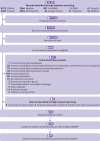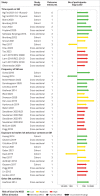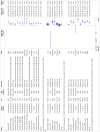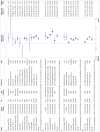Social media use and health risk behaviours in young people: systematic review and meta-analysis
- PMID: 38030217
- PMCID: PMC10685288
- DOI: 10.1136/bmj-2022-073552
Social media use and health risk behaviours in young people: systematic review and meta-analysis
Abstract
Objectives: To examine the association between social media use and health risk behaviours in adolescents (defined as those 10-19 years).
Design: Systematic review and meta-analysis.
Data sources: EMBASE, Medline, APA PsycINFO, SocINDEX, CINAHL, SSRN, SocArXic, PsyArXiv, medRxiv, and Google Scholar (1 January 1997 to 6 June 2022).
Methods: Health risk behaviours were defined as use of alcohol, drugs, tobacco, electronic nicotine delivery systems, unhealthy dietary behaviour, inadequate physical activity, gambling, and anti-social, sexual risk, and multiple risk behaviours. Included studies reported a social media variable (ie, time spent, frequency of use, exposure to health risk behaviour content, or other social media activities) and one or more relevant outcomes. Screening and risk of bias assessments were completed independently by two reviewers. Synthesis without meta-analysis based on effect direction and random-effects meta-analyses was used. Effect modification was explored using meta-regression and stratification. Certainty of evidence was assessed using GRADE (Grading of Recommendations, Assessment, Development and Evaluations).
Results: Of 17 077 studies screened, 126 were included (73 included in meta-analyses). The final sample included 1 431 534 adolescents (mean age 15.0 years). Synthesis without meta-analysis indicated harmful associations between social media and all health risk behaviours in most included studies, except inadequate physical activity where beneficial associations were reported in 63.6% of studies. Frequent (v infrequent) social media use was associated with increased alcohol consumption (odds ratio 1.48 (95% confidence interval 1.35 to 1.62); n=383 068), drug use (1.28 (1.05 to 1.56); n=117 646), tobacco use (1.85, 1.49 to 2.30; n=424 326), sexual risk behaviours (1.77 (1.48 to 2.12); n=47 280), anti-social behaviour (1.73 (1.44 to 2.06); n=54 993), multiple risk behaviours (1.75 (1.30 to 2.35); n=43 571), and gambling (2.84 (2.04 to 3.97); n=26 537). Exposure to content showcasing health risk behaviours on social media (v no exposure) was associated with increased odds of use of electronic nicotine delivery systems (1.73 (1.34 to 2.23); n=721 322), unhealthy dietary behaviours (2.48 (2.08 to 2.97); n=9892), and alcohol consumption (2.43 (1.25 to 4.71); n=14 731). For alcohol consumption, stronger associations were identified for exposure to user generated content (3.21 (2.37 to 4.33)) versus marketer generated content (2.12 (1.06 to 4.24)). For time spent on social media, use for at least 2 h per day (v <2 h) increased odds of alcohol consumption (2.12 (1.53 to 2.95); n=12 390). GRADE certainty was moderate for unhealthy dietary behaviour, low for alcohol use, and very low for other investigated outcomes.
Conclusions: Social media use is associated with adverse health risk behaviours in young people, but further high quality research is needed to establish causality, understand effects on health inequalities, and determine which aspects of social media are most harmful.
Study registration: PROSPERO, CRD42020179766.
© Author(s) (or their employer(s)) 2019. Re-use permitted under CC BY. No commercial re-use. See rights and permissions. Published by BMJ.
Conflict of interest statement
Competing interests: All authors have completed the ICMJE uniform disclosure form at www.icmje.org/disclosure-of-interest/ and declare: no support from any organisation for the submitted work; no financial relationships with any organisations that might have an interest in the submitted work in the previous three years; no other relationships or activities that could appear to have influenced the submitted work.
Figures





References
-
- Kemp S. Facebook statistics and trends. DataReportal. 2022. https://datareportal.com/essential-facebook-stats [accessed 29 August 2022]
-
- Kemp S. Instagram statistics and trends. DataReportal. 2022. https://datareportal.com/essential-instagram-stats [accessed 29 August 2022]
-
- Gebremeskel RH, Sessoms K, Krehnbrink M, Haney CJ, Coyne-Beasley T. Social media use and adolescent risk taking behavior. J Adolesc Health 2014;54:S46-7. 10.1016/j.jadohealth.2013.10.106. - DOI
Publication types
MeSH terms
Grants and funding
LinkOut - more resources
Full Text Sources
